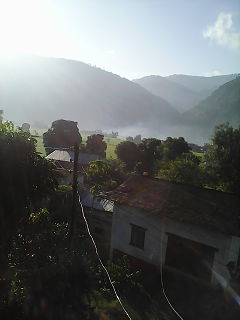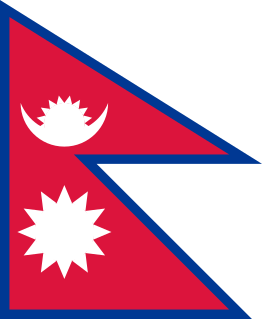
Dhamja is a village development committee in Baglung District in the Dhaulagiri Zone of central Nepal. At the time of the 1991 Nepal census it had a population of 2,571 and had 497 houses in the village. Only some basic developmental infrastructure are on its way to Dhamja. Most people are dependent to the traditional agriculture for their living. Millet, Barley, Rice, Wheat and different kind of seasonal fruits and vegetables are the major crops. The foreign remittance is also considered as one of the major source of income for the people living there.

Listikot is a village in Sindhupalchok District in the Bagmati Zone of central Nepal. At the time of the 1991 Nepal census it had a population of 3664 and had 714 houses in the village.

Dilasaini is a former village development committee that is now a Rural Municipality in Baitadi District in Province No. 7 of western Nepal. At the time of the 1991 Nepal census it had a population of 4,828 and had 849 houses in the village. There is one plus two, two high schools and many primary schools in the VDC. This VDC is bordered by Mathairaj, Gokuleshwor, Rudreswor and Rim VDC and Darchula district in the northwest. Ths VDC is named after a local deity. The temple of this devi is located in Dhamigaun which is one of the wards of the VDC. This temple is famous in far-western Nepal for the sacrifice of huge number of bull buffaloes on occasion of Dashain.

Lakshmanpur is a town in Banke District in the Bheri Zone of south-western Nepal. At the time of the 1991 Nepal census it had a population of 3,416 and had 668 houses in the town.

Naubasta is a town in Banke District in the Bheri Zone of south-western Nepal. At the time of the 1991 Nepal census it had a population of 11,160 and had 1663 houses in the town.

Shankhupati chaur is a village development committee in Kavrepalanchok District in the Bagmati Zone of central Nepal. At the time of the 1991 Nepal census it had a population of 3246 in 585 individual households.

Dhurkot Nayagaun is a town and municipality in Gulmi District in the Lumbini Zone of central Nepal. At the time of the 1991 Nepal census it had a population of 4692. This VDC is one of the most beautiful VDC of Gulmi and famous for Oranges. Literacy rate of this VDC is above 90℅. Politically above 75% people support CPM UML in this village. This VDC is touched by Arghakhanchi district.

Rupakot is a Village Development Committee (VDC) in Gulmi District in the Lumbini Zone of central Nepal. Its headquarters is in Myal pokhara. It is located in about the center of Gulmi District. It is surrounded by hills. Its main religion is Hinduism. There are many temples like Chhatra Thaan, Shiddababa temple, Shiva Temple, Ram Temple,Debi deurali temple etc. The main sources of revenue for the village are agriculture and foreign employment. At the time of the 2001 Nepal census, it had a population of 3521 persons residing in 704 individual households. 76.48% of students attend school. The most populated parts of this VDC is Damuka, Sota & Ekle Pipal.

Gadhawa (Gadawa) is a village in the Gadhawa Rural Municipality of Dang Deukhuri District in Province No. 5, south-western Nepal. It was, prior to September 2015, also a Village Development Committee in Dang Deukhuri District, Rapti Zone. At the time of the 2011 Nepal census the VDC had a population of 11,430 persons living in 2,176 households, up from the 2001 Nepal census of 7,877 persons living in 1,188 households.

Saudiyar is a town and Village Development Committee in Dang Deokhuri District in the Rapti Zone of south-western Nepal. At the time of the 1991 Nepal census it had a population of 8,052 persons living in 1067 individual households.

Dhikurpokhari is a suburb and Village Development Committee in Kaski District in the Gandaki Zone of northern-central Nepal. At the time of the 1991 Nepal census it had a population of 7,392 persons living in 1,427 individual households.

Parche is a town and Village Development Committee in Kaski District in the Gandaki Zone of northern-central Nepal. At the time of the 1991 Nepal census it had a population of 3,182 persons living in 669 individual households.

Purkot is a village development committee in Tanahu District in the Gandaki Zone of central Nepal. At the time of the 2011 Nepal census it had a population of 7,188! among them 3,044(male) 4,144(female). This VDC is located on the highway called vanu highway(Dumre-besishahar) and has a small town called Baishjangar where Police station, health posts, schools and some other major facilities available.This village is somehow called as a transit for another neighboring districts Lamjung and Gorkha. Well famous river Marshyandi flows through this place. The village consists of various casts of people such as major Brahman Tamang-Gurung including, Newar, and Chettris etc. and equally celebrates their festivals each other.Purkot:The main income sources for the VDC is remittance as well Agriculture and small business. ward number: 1-9 Baishjangar which is main city(bazar). Police station and school: ward no. 5 in Kharpani. Purkot has some major high school in the town which are Shree Kalika multiple campus and Karmada secondary school. b

Subhang or Suvang is a village development committee in Panchthar District in the Mechi Zone of eastern Nepal. At the time of the 1991 Nepal census it had a population of 4862 people living in 800 individual households. Mostly Limbu people live here.Others ethnic groups are Tamang, Sherpa, Brahmins, Rai, Chhettris etc. Suhang, Yonghang, Pandhak, Moktan, Ojha, Mainali, Rais etc surnamed people live here. It is surrounded by Bharapa,Ekteen,Panchami, Tharpu, Chiyandada and Chattedhunga VDCs.Suvang khola and Tambar Khola are the majors river. Mostly kirant religion is followed.Also Buddhism, Hinduism etc follower can be found. Jorpokhari and Chatture bazaar are major market areas.Every two weeks chatture local mela is organised. Main economic activities include Agriculture.Animal husbandry,Cash crops and staple crops are cultivated. Animal husbandry includes chickens, pigs, cow, goat, buffalo, sheep etc. And main cash crop includes Cardamom. Other cash crops may include Amlisho, Ginger and vegetables.

Shivanagar was a village development committee in Chitwan District in the Narayani Zone of southern Nepal. At the time of the 1991 Nepal census it had a population of 6937 people living in 1314 individual households.

Amarapuri is a town in Gaidakot Municipality in Nawalparasi District in the Lumbini Zone of southern Nepal. It became a municipality in May 2014 by merging the existing Mukundapur, Amarapuri, Gaidakot, Nawalparasi, VDCs. At the time of the 1991 Nepal census it had a population of 5,451 living in 967 households. Amarapuri has three high schools, the Shree Laxmi Higher Secondary School, Amar Jyoti Higher Secondary School and Amar English Higher Secondary Boarding School.

Mirkot is a village development committee in Gorkha District in the Gandaki Zone of northern-central Nepal. It lies on the western side of the headquarters of Gorkha. According to the National Population and Housing Census 2011, it had a population of 5261, and had 1388 households in the village. Its neighbourhood VDCs are Gaikhur, Dhuwakot, Khoplang, Chyangli, Palumtar, Chhoprak and Deurali. Such as Kotgadi, Lakang, Mahadev Temple are the most important places of Mirkot. The central part of Mirkot VDC is called Bagdanda, Where the main office of the VDC and Mirkot Higher Secondary School are located.

Bhanu is a municipality of Tanahun District in Gandaki Zone of western Nepal. The municipality was established on 19 September 2015 by merging the existing Bhanu village development committees(VDCs), Barbhanjyang village development committees (VDCs), Rupakot village development committees (VDCs), Tanahunsur Village Development Committee, Purkot VDC, Mirlung VDC, Satiswara VDC, Risti VDC, Basantapur VDC and Chok Chisapani VDC. The center of the municipality is establish in former VDC Office of Bhanu. After merging the population of all of the VDCs, it had a total population of 46,179 according to 2011 Nepal census. After the government decision the number of municipalities has reached 217 in Nepal. Famous Nepali poet Bhanubhakta Acharya was born in Bhanu Municipality .The place is named after him as Bhanu Municipality.

Yangwarak is a rural municipality (gaunpalika) out of seven rural municipality located in Panchthar District of Province No. 1 of Nepal. There are a total of 8 municipalities in Panchthar in which 1 is urban and 7 are rural.









